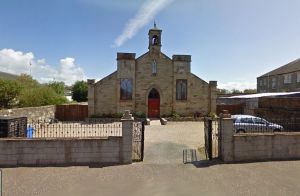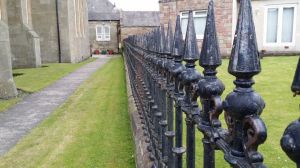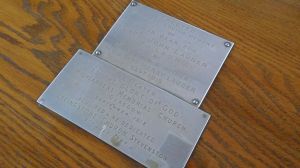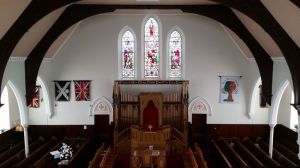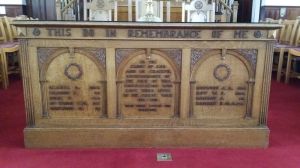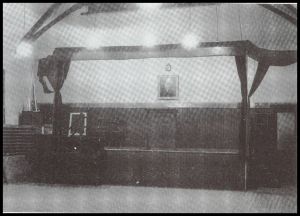In the year 1843 the Rev. Dr. Landsborough, minister of Stevenston Parish Church (the High Kirk), walked out of the General Assembly Hall of the Church of Scotland, along with a great number of other ministers and elders, to found the Free Church of Scotland. The event became known as “The Disruption” and was to lead eventually to an entirely new relationship between Church and State in Scotland. Livingstone Church has its roots in this action of Dr. Landsborough and others.
At first, the new Free Church minister and his new members could not secure a site in Stevenston for a Church. A site was found, however, in Saltcoats and a Church built – later to be called Landsborough Church and used by the Church of Scotland, but now demolished.
The First Buildings
With one third of the members of this new congregation coming from Stevenston, it was not long before there was a fresh move to establish a congregation in that community itself. Patrick Warner, a local landowner, gave the site, the people gave the money, and the first Church was built and opened for worship by February 1845. It was, until the later part of the 20th century, still the building of the Free Church of Scotland. Then, it became part of the business premises of Messrs. James Frew Ltd., members of a family long associated with our Church, and through whose generosity a plaque has been placed on the building to commemorate its place in the history of our congregation. Recently, the building was converted to a private dwelling. Soon after the first Church opened, a manse for the new minister was built at a cost of £500.
A New Church
It would seem to us a big enough challenge to build one Church. But, only thirty-eight years later, in 1883, the congregation, under the ministry of Mr. Joseph Forrest, embarked on a plan to erect a new Church. Mr. Forrest himself, though by that time no longer the minister of the Church, gave an interesting account of why they embarked on this project, in an address on the evening of the opening of the new Church. Three things he said motivated them. They were cold in Winter, stifled in Summer, and needed more room for their work, especially among the young in Sunday School and Band of Hope. He and his office-bearers had raised monies and promises amounting to £800 by 1885, when he was called to Douglas, Isle of Man. In addition, they had the promise of some special grants, from the Free Church and Trusts, towards the estimated £2000 to erect the new building.
It was left, however, to John Livingstone, his successor, to complete the work. The minute of the Deacon’s Court of 26th April 1886 records the decision very simply:
It was agreed to proceed with the erection of a new Church.
Patrick Warner again provided the site and also gave a subscription towards the new building. The architect was a Mr. Petrie of Glasgow, who supervised the erection of the present Church and Lesser Hall at an entire cost of £1800 not including the £200 worth of ironwork gifted by the Kerrs of Ardeer Foundry. (Only a little of this ironwork now remains on either side of our building, together with the two iron pillars at our front gate). The stone of the building came from the local Stevenston Quarry of Messrs. Woodburn and Douglas, apart from the granite columns at the front door which came from Peterhead.
The Workmen
It seems right to name the tradesmen involved, because a hundred and twenty-eight years later we can still testify that they built well and were workmen who had no need to be ashamed.
| Mason | Messrs. John Young of Stevenston |
| Joiner | Mr. William Young of Stevenston |
| Slater | Messrs. Kier of Irvine |
| Plumber/Heating Engineer/Gas Fitter | Mr. Thomas Hall of Irvine |
| Plasterer | Mr. David Stobie of Irvine |
| Upholsterer | Mr. Cunningham of Glasgow |
All the workmen were chosen as a result of tenders secured by advertisement in “The Ardrossan and Saltcoats Herald”, “The Ayrshire Daily News”, and “The Kilmarnock Standard”.
Laying the Foundation
On Saturday 4th September 1886, Mrs. Mure-Macredie of Perceton House (now part of North Ayrshire Council) accompanied by her daughters, the Misses Mure, laid the Foundation Stone above what was to be the front entrance of the new Church. In a cavity in the stone was placed in a bottle – the then coins of the realm from one farthing to half-sovereign, copies of “The Ardrossan and Saltcoats Herald”, “Ayrshire Weekly News”, “Glasgow Daily Herald”, “Glasgow Daily Mail”, and “The Scotsman”, a copy of the authorised version of the Bible, the “Free Church Monthly Record” and “Children’s Record”, a list of the names of the minister and office-bearers, architect and tradesmen, the names of Mrs. Macredie and her daughters, and of the ministers present.
The Opening
On Thursday, the 7th July 1887, at noon, the Church was opened and dedicated to the glory of God by the Rev. Alexander Whyte of Free St. George’s, Edinburgh. In the evening there was a thanksgiving meeting conducted by the Rev. Joseph Forrest, the former minister, whose interest in the work had continued, even to the extent of a tangible gift.
The opening services on Sunday, 10th July 1887 were packed. Three services were held in the morning, afternoon and evening, and the offerings for the day amounted to £103 10s 2 3/4d., huge for those days when £20 was a reasonable monthly income for our congregation which then had about 200 members.
It would be easy to paint too rosy a picture of the financial situation. In fact, they had several hundreds of pounds of debt. They overcame it with the retrospective help of the Ferguson Bequest who gave £150, and who subsenquently, a hundred years later were to give £1,010 to renovate the building.
There was also the great personal generosity of Mr. J. W. Boyd, a member of the Church, who purchased for £160 the former Church building, which the congregation had decided to sell to raise money, and who gave it back to them to be used as their Church Hall. This it remained, renamed “The Woodside Hall”, until our congregation became part of the United Free Church of Scotland. After a legal wrangle involving all former Free Church congregations we, in common with others, had to give up part of our premises to the continuing Free Church. Our congregation, then, gave up its hall in 1904.
It was the loss of the original Church which led to the building of our new hall in 1912. The architect was Mr. Hugh Thomson, an uncle of our former treasurer, Dick Thomson. What strikes you reading through the minutes of these past events is the generosity of our forefathers. On the evening, for instance, when Mr. Boyd made his generous offer to purchase the old Church, Mr. Kerr of the iron foundry offered £115 in loan over two years. The remaining members of the Deacons’ Court, consisting of two weavers, a mining overseer, a farmer, a chemist, a miner, two moulders, a gardener, and the inevitable dynamite worker, gave that night, or promised to give, £52, and to undertake house-to-house collections to clear the debt, especially money borrowed from the Bank of Scotland under the agency of Mr. James Campbell. Yet, at their next meeting, these same office-bearers, beset as they were with debt, arranged to have two collection boxes placed in the front vestibule of the Church for “The Poor” and for “Foreign Missions”. They had their priorities right as did the congregation in 1987 by meeting their wider commitments during the raising of money for renovation.
The Changing Scene
No buildings as old as ours could remain unchanged. By and large, however, these changes have taken place within. We started off, for instance, with a precentor leading worship. In 1898 it was decided to introduce instrumental music and an organ was purchased. It was 1944 before a pipe organ was installed. Originally presented to the Highlander’s Memorial Church in Glasgow by Sir Harry Lauder, the famous Scots comedian, in memory of his son, John, killed in the First World War, it was purchased by our congregation in 1943. Mr. Archibald, Church organist for many years, and the members of the choir were the inspiration of this move. The dedication took place on Sunday 9th July 1944 at a special afternoon service. Meg Faulds, one of our members was one of the two soloists on that occasion. The choir under Mr. Archibald presented a number of pieces. The special guest organist was Purcell J. Mansefield who incidentally later taught our former minister, Mr. Roy, music in Camphill School in Paisley. As the organ was installed during the 2nd World war, the materials used although the best available, may not have been ideal. In recent years, the organ fell into disrepair as the maintenance costs rapidly increased. The decision was taken in the mid 2000’s to purchase a clavinova which is now used during worship. Current Church organist Mary Munn recalls former minister Mr. Nimmo actively encouraging her to play the piano for the Sunday School as a twelve year old in the late 1940’s. Many decades later she became our Church organist after the retiral of Mr. Archibald and remains so to this day.
Few visiting our Church could fail to notice the fine stained glass windows presented by Mr. James Morrison, the first Provost of Stevenston, and for so many years our Session Clerk. These windows were installed in our Jubilee Year, 1937, and dedicated at the morning service on July 4th, a memorial to Mr. Morrison’s wife and daughter.
Over the years Mr. Morrison gave many other gifts including our communion table, which is a memorial to those who died in the First World War (a wall plaque commemorates those who were killed in the Second World War), the communion lecturn, and some communion ware.
One work which lightened the interior of our Church was the stripping of varnish from the Church pews. This was a difficult job carried out by voluntary labour under the direction of Mr. David McAuslan.
Many items of Church furnishing have come to us gradually over the years from other sources. The choir chairs were gifted by the Girl Guides in memory of Miss Grace Boyd. The Guides and Youth Fellowship carpeted the choir area which previously was covered in lino. All the Youth organisations raised the money to furnish our Session Room as it is today. The skilled workers of the Co-operative Furniture Factory in Beith carried out the work to David Frew’s design.
This latter work was carried out at the time of major hall renovation in 1962-63. This transformed our halls from their Victorian state to the bright modern halls we have today. A new floor was laid, the premises rewired, sound-proofing introduced betweem the Large and Lesser Halls, kitchen and toilets brought up-to-date, bright decor devised by Bill Kerr and executed by David and Frank McAuslan. Dick Maxwell, the joiner, made our present Church lecturn from material used to renovate the hall floors. From the old church hall forms of pitch pine he also made the furniture for the vestry and the kitchen.
Centenary Renovation (1987)
In 1987, the Church embarked on a large renovation project to mark the centenary year. Again, the renovations of the Church and Halls were blessed by the skills of able workmen, some of them members, all of them became friends. The work carried out consisted of the cleaning and refurbishment of the Church stonework, the re-roofing of the Church, the installation of new unbreakable(!) windows in the Church, the copper on the Church spire was renewed, fresh gutters and down-pipes provided, rewiring and repainting of Church and Halls, and the provision of extensive new storage accommodation. The total cost was £50,000, a figure which puts no price tag on the work of Community Industry and voluntary labour.
This major work of renovation was carried out with dedication and enthusiasm by:
| Slater | R. & A. Auld – Stevenston |
| Plumber | Archibald & Godfree – Ardrossan |
| Joiner/Glazier | A. W. Blair – Stevenston |
| Stonework | Hunter & Clark – Glasgow |
| Painting | Community Industry – Kilmarnock |
who were the main contractors working under the supervision of Honeyman, Jack, & Robertson of Glasgow who were the architects. Through the generous assistance of I.C.I our Church bell was also renovated and re-hung. It was then that we discovered that it had served in another Church prior to Livingstone, for the inscription ran thus:
Presented to Free Anderston Church
by R. B. Stewart, Esq
David Burgess, Founder, Glasgow 1849
No. 266
In 1930 there was a suggestion that a sound system for the deaf be installed. The matter was deferred until the deaf specifically asked for one! Fifty-six years later they did and an induction loop system was installed by Alex Woodside and George Oberst. The ways of the Church are sometimes slow!
Continuing Witness
There is more. Much of the history has been omitted and many have gone unmentioned. What it all speaks of is a dedicated people who for over 130 years have loved their building not for itself but as the place where God could be worshipped, His Word heard, His sacraments reveal Him, and the fellowship honour Him. We thank God for the inheritance of His House and for the love and fellowship which over the years succeeding generations have experienced within it.

